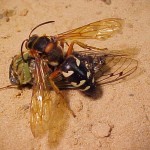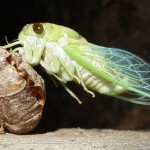San Antonio Express News
GARDENING, Etc.
Sunday, August 22, 2004
By Nathan Riggs
When one thinks of wasps, the mind envisions little paper nests stocked with winged fury hanging from the eaves of a building, tree branch or some other location. Wasps are very common inhabitants in South Texas and occupy a wide variety of niches. Most wasps are predaceous, feeding on insects and proteins, while some pollinate flowers or act as parasites on other insects. It is this last activity that has attracted the attention (and concern) of homeowners across the area. What type of insect are we speaking of? Does the cicada killer wasp come to mind? It should.
 Cicada killers (Sphecius speciosus) are related to mud daubers or dirt daubers on the wasp family tree. They average greater than one inch in length and are recognized by their amber-colored wings and yellow/orange/black bodies. Cicada killers’ size leads one to believe that they are aggressive and dangerous. They are frequently seen zooming around just above the grass or soil and sometimes they are observed crashing into windows.
Cicada killers (Sphecius speciosus) are related to mud daubers or dirt daubers on the wasp family tree. They average greater than one inch in length and are recognized by their amber-colored wings and yellow/orange/black bodies. Cicada killers’ size leads one to believe that they are aggressive and dangerous. They are frequently seen zooming around just above the grass or soil and sometimes they are observed crashing into windows.
These patrolling behaviors are exhibited by the male cicada killer. Males patrol territories for females and will chase other males away; hence the window-crashing behavior when they see their reflection. Above all of this, male cicada killers do not possess a stinger and, therefore, cannot sting.
Female cicada killers come equipped with a stinger but rarely use it, even when provoked. They have a better use for their stinger and we’ll see why.
Cicada killers get their name because the females hunt (during the summer months) in trees to find and capture cicadas. Once found, a cicada is stung and paralyzed by the female cicada killer and dragged to a location on the ground where the soil is loose and fluffy. The cicada killer then digs a tunnel, and drags the paralyzed cicada down into it where she lays an egg on the cicada which hatches into a larva and feeds.
- The Hunter – Photo: TAMU-Drees
- Let the games begin, as these two giants of the insect world, face off – both in the effort to survive. – Photo: TAMUhttp://agnews.tamu.edu/dailynews/stories/ENTO/Aug0503a.htm
- The Hunted – Photo: TAMU-Bohlmeyer
Cicada killers are solitary and do not share tunnels, but several females may use the same area, making it appear that there is a “nest” of them.
Many calls have come in to the Bexar County Extension office this summer with stories of “30 or 40” wasps mulling around a backyard deck or flower beds. Although cicada killers are harmless, some homeowners still want these giant wasps to go away.
There are two ways to deal with cicada killers. The first is a non-chemical option that uses weed-blocking landscape fabric. Clear the nesting area of weeds, leaves and mulch, lay down the fabric and cover it with two to three inches of fresh mulch. This should deter any further digging in that area.
The second option involves using dust insecticides. Find the active tunnels and apply a small amount (one or two teaspoons) of any dust insecticide to the tunnel opening, but DO NOT close the tunnel. This will allow the cicada killer to track the dust into the tunnel. Sprays or granules will provide some benefit, but not as well as dust insecticides.
Cicada killers are the undisputed giants of the wasp world in Texas. They appear soon after cicadas begin singing their summer songs in the trees and will remain active until fall. Cicadas certainly cause concern by their large size, but they are considered to be harmless by experts. Treating their tunnels can provide fast results if one intends to deal with them after they appear. A little respect and understanding about these “gentle giants” can mean the difference between panic and patience.
This article was written by Nathan Riggs, Extension Agent-IPM, with Texas Cooperative Extension in Bexar County.


